University Sociology: Cultural Diversity Reflection Assignment
VerifiedAdded on 2022/10/11
|5
|1040
|13
Homework Assignment
AI Summary
This sociology assignment is a reflection on cultural diversity, focusing on the student's Punjabi heritage and experiences. The student utilizes the Gibbs Reflective Cycle to analyze their cultural background, beliefs, and how these factors shape their perspective on the world. The assignment explores the influence of culture on individual viewpoints, family dynamics, and societal values. The student describes their feelings, evaluations, and analysis related to their cultural identity, highlighting aspects like unity, equality, and the impact of historical and social changes. They also outline a future action plan, expressing a desire to approach other cultures with rationalism and equality while minimizing cultural differences. The assignment demonstrates self-awareness and critical thinking about the student's cultural lens and its impact on their understanding of the world.
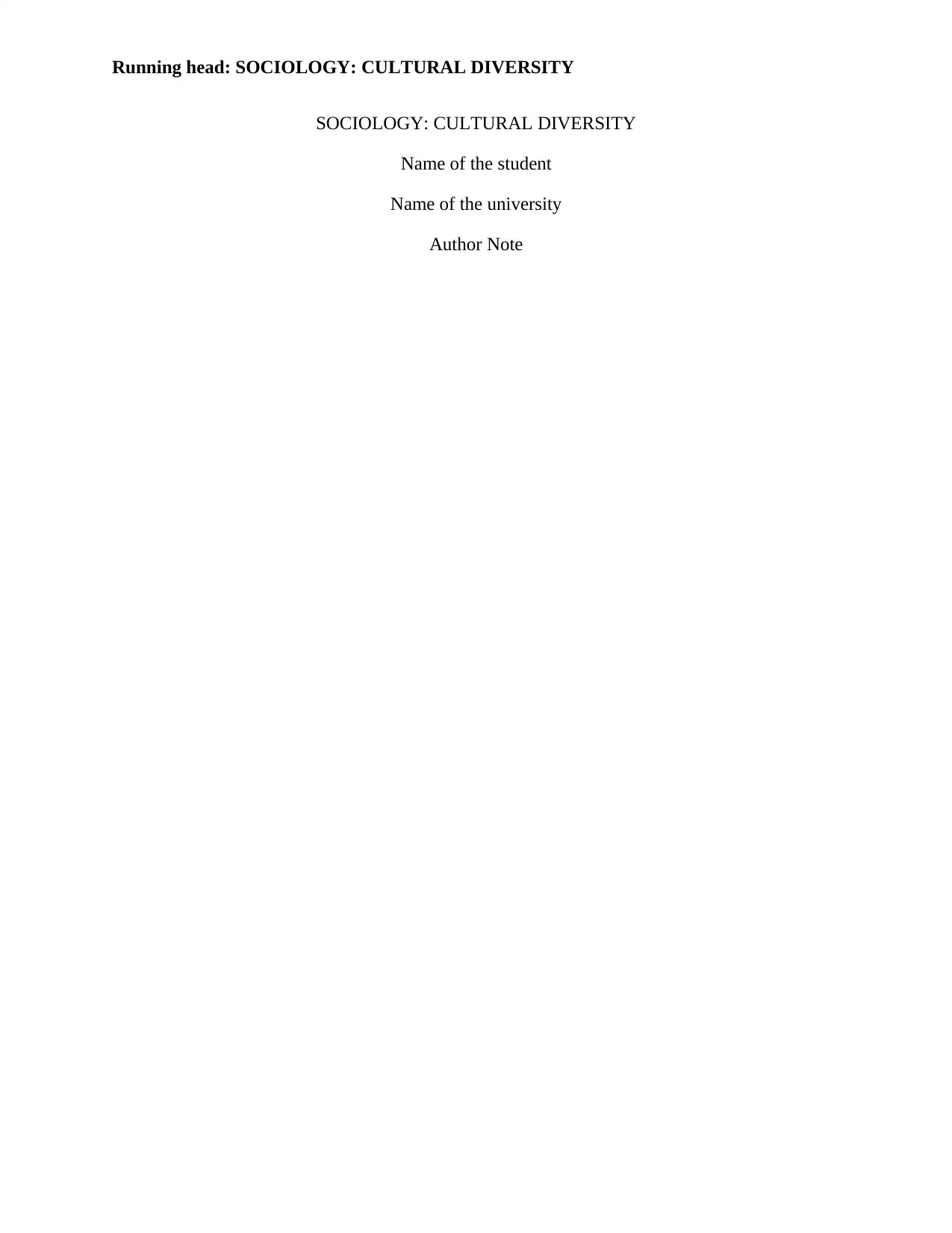
Running head: SOCIOLOGY: CULTURAL DIVERSITY
SOCIOLOGY: CULTURAL DIVERSITY
Name of the student
Name of the university
Author Note
SOCIOLOGY: CULTURAL DIVERSITY
Name of the student
Name of the university
Author Note
Paraphrase This Document
Need a fresh take? Get an instant paraphrase of this document with our AI Paraphraser
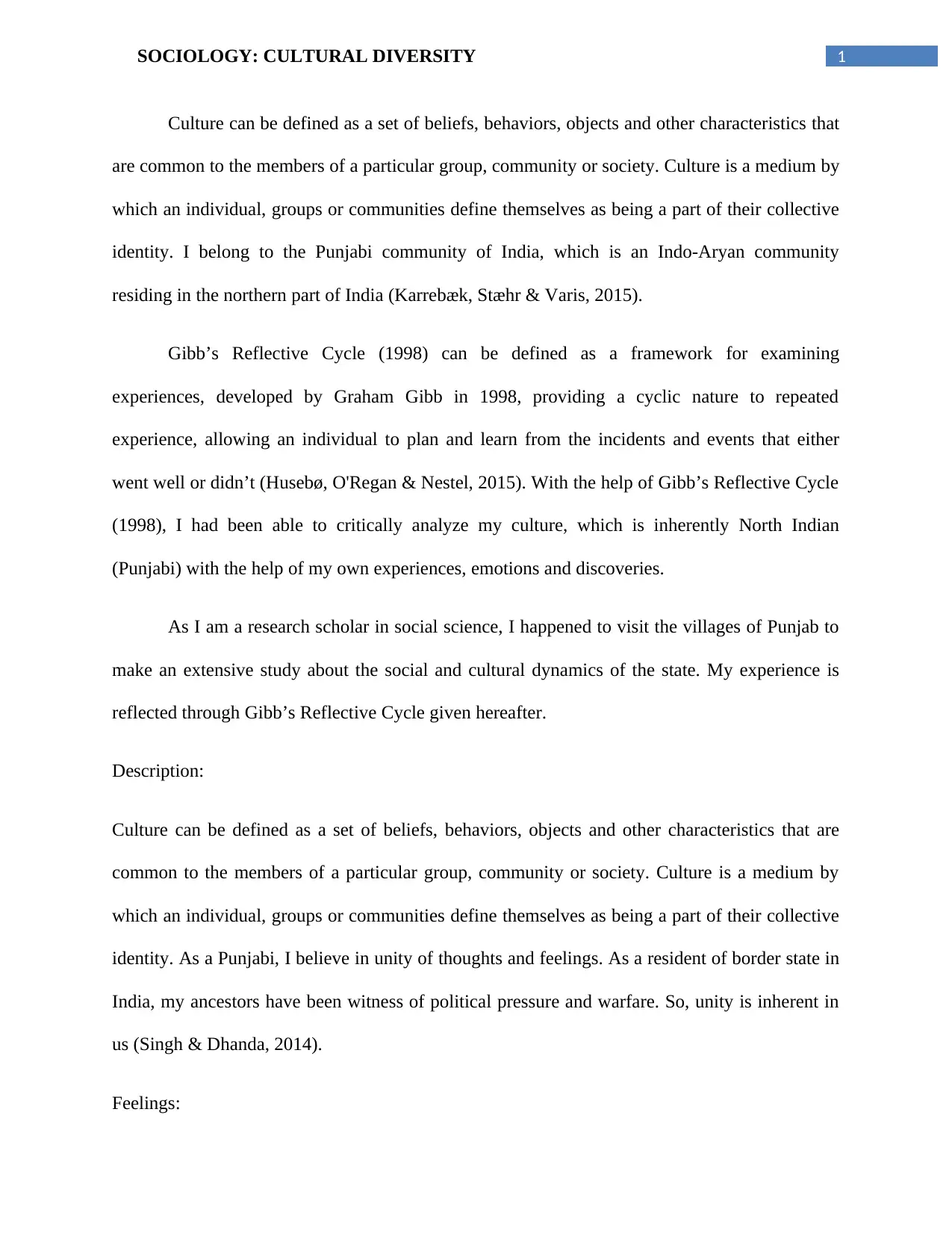
1SOCIOLOGY: CULTURAL DIVERSITY
Culture can be defined as a set of beliefs, behaviors, objects and other characteristics that
are common to the members of a particular group, community or society. Culture is a medium by
which an individual, groups or communities define themselves as being a part of their collective
identity. I belong to the Punjabi community of India, which is an Indo-Aryan community
residing in the northern part of India (Karrebæk, Stæhr & Varis, 2015).
Gibb’s Reflective Cycle (1998) can be defined as a framework for examining
experiences, developed by Graham Gibb in 1998, providing a cyclic nature to repeated
experience, allowing an individual to plan and learn from the incidents and events that either
went well or didn’t (Husebø, O'Regan & Nestel, 2015). With the help of Gibb’s Reflective Cycle
(1998), I had been able to critically analyze my culture, which is inherently North Indian
(Punjabi) with the help of my own experiences, emotions and discoveries.
As I am a research scholar in social science, I happened to visit the villages of Punjab to
make an extensive study about the social and cultural dynamics of the state. My experience is
reflected through Gibb’s Reflective Cycle given hereafter.
Description:
Culture can be defined as a set of beliefs, behaviors, objects and other characteristics that are
common to the members of a particular group, community or society. Culture is a medium by
which an individual, groups or communities define themselves as being a part of their collective
identity. As a Punjabi, I believe in unity of thoughts and feelings. As a resident of border state in
India, my ancestors have been witness of political pressure and warfare. So, unity is inherent in
us (Singh & Dhanda, 2014).
Feelings:
Culture can be defined as a set of beliefs, behaviors, objects and other characteristics that
are common to the members of a particular group, community or society. Culture is a medium by
which an individual, groups or communities define themselves as being a part of their collective
identity. I belong to the Punjabi community of India, which is an Indo-Aryan community
residing in the northern part of India (Karrebæk, Stæhr & Varis, 2015).
Gibb’s Reflective Cycle (1998) can be defined as a framework for examining
experiences, developed by Graham Gibb in 1998, providing a cyclic nature to repeated
experience, allowing an individual to plan and learn from the incidents and events that either
went well or didn’t (Husebø, O'Regan & Nestel, 2015). With the help of Gibb’s Reflective Cycle
(1998), I had been able to critically analyze my culture, which is inherently North Indian
(Punjabi) with the help of my own experiences, emotions and discoveries.
As I am a research scholar in social science, I happened to visit the villages of Punjab to
make an extensive study about the social and cultural dynamics of the state. My experience is
reflected through Gibb’s Reflective Cycle given hereafter.
Description:
Culture can be defined as a set of beliefs, behaviors, objects and other characteristics that are
common to the members of a particular group, community or society. Culture is a medium by
which an individual, groups or communities define themselves as being a part of their collective
identity. As a Punjabi, I believe in unity of thoughts and feelings. As a resident of border state in
India, my ancestors have been witness of political pressure and warfare. So, unity is inherent in
us (Singh & Dhanda, 2014).
Feelings:
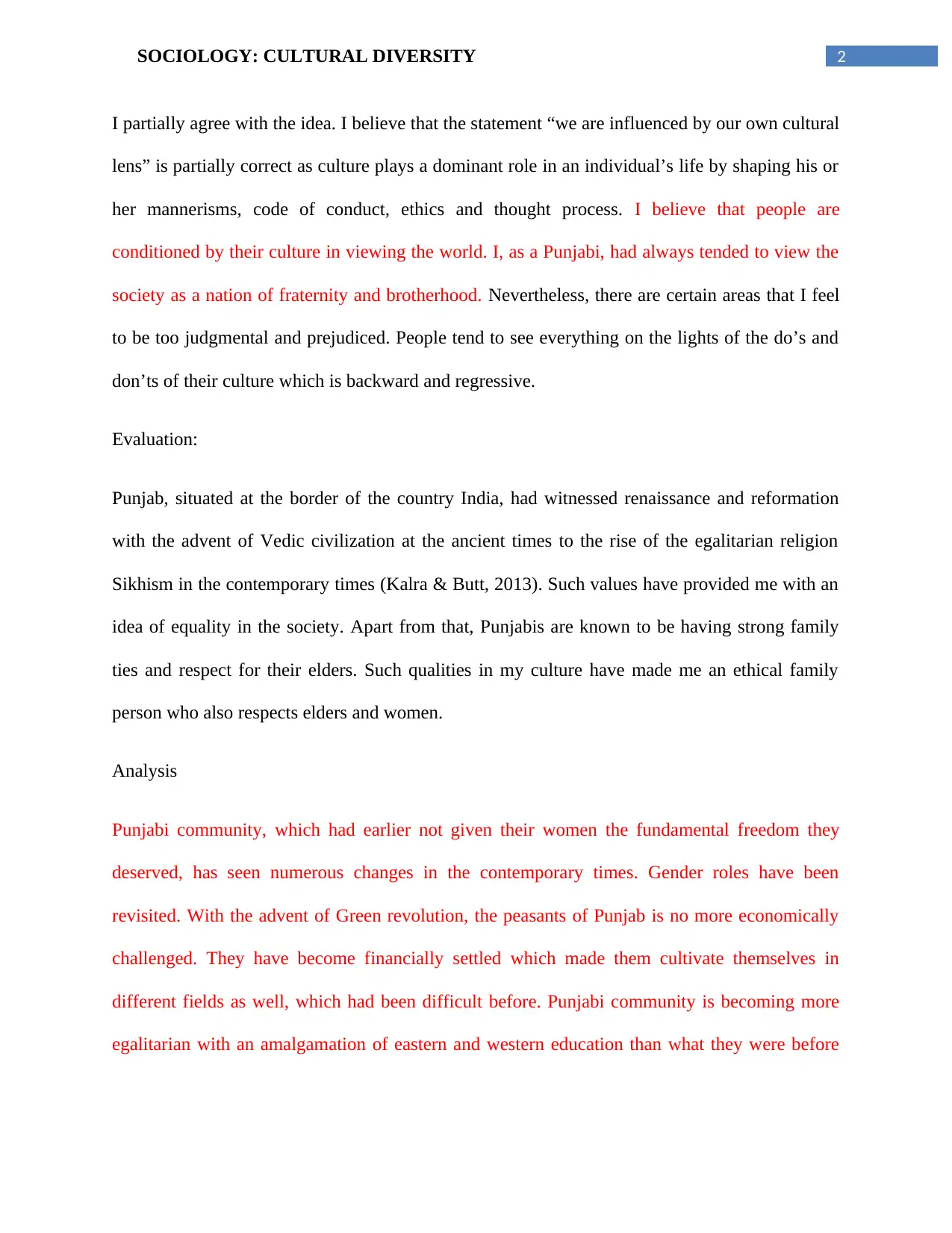
2SOCIOLOGY: CULTURAL DIVERSITY
I partially agree with the idea. I believe that the statement “we are influenced by our own cultural
lens” is partially correct as culture plays a dominant role in an individual’s life by shaping his or
her mannerisms, code of conduct, ethics and thought process. I believe that people are
conditioned by their culture in viewing the world. I, as a Punjabi, had always tended to view the
society as a nation of fraternity and brotherhood. Nevertheless, there are certain areas that I feel
to be too judgmental and prejudiced. People tend to see everything on the lights of the do’s and
don’ts of their culture which is backward and regressive.
Evaluation:
Punjab, situated at the border of the country India, had witnessed renaissance and reformation
with the advent of Vedic civilization at the ancient times to the rise of the egalitarian religion
Sikhism in the contemporary times (Kalra & Butt, 2013). Such values have provided me with an
idea of equality in the society. Apart from that, Punjabis are known to be having strong family
ties and respect for their elders. Such qualities in my culture have made me an ethical family
person who also respects elders and women.
Analysis
Punjabi community, which had earlier not given their women the fundamental freedom they
deserved, has seen numerous changes in the contemporary times. Gender roles have been
revisited. With the advent of Green revolution, the peasants of Punjab is no more economically
challenged. They have become financially settled which made them cultivate themselves in
different fields as well, which had been difficult before. Punjabi community is becoming more
egalitarian with an amalgamation of eastern and western education than what they were before
I partially agree with the idea. I believe that the statement “we are influenced by our own cultural
lens” is partially correct as culture plays a dominant role in an individual’s life by shaping his or
her mannerisms, code of conduct, ethics and thought process. I believe that people are
conditioned by their culture in viewing the world. I, as a Punjabi, had always tended to view the
society as a nation of fraternity and brotherhood. Nevertheless, there are certain areas that I feel
to be too judgmental and prejudiced. People tend to see everything on the lights of the do’s and
don’ts of their culture which is backward and regressive.
Evaluation:
Punjab, situated at the border of the country India, had witnessed renaissance and reformation
with the advent of Vedic civilization at the ancient times to the rise of the egalitarian religion
Sikhism in the contemporary times (Kalra & Butt, 2013). Such values have provided me with an
idea of equality in the society. Apart from that, Punjabis are known to be having strong family
ties and respect for their elders. Such qualities in my culture have made me an ethical family
person who also respects elders and women.
Analysis
Punjabi community, which had earlier not given their women the fundamental freedom they
deserved, has seen numerous changes in the contemporary times. Gender roles have been
revisited. With the advent of Green revolution, the peasants of Punjab is no more economically
challenged. They have become financially settled which made them cultivate themselves in
different fields as well, which had been difficult before. Punjabi community is becoming more
egalitarian with an amalgamation of eastern and western education than what they were before
⊘ This is a preview!⊘
Do you want full access?
Subscribe today to unlock all pages.

Trusted by 1+ million students worldwide
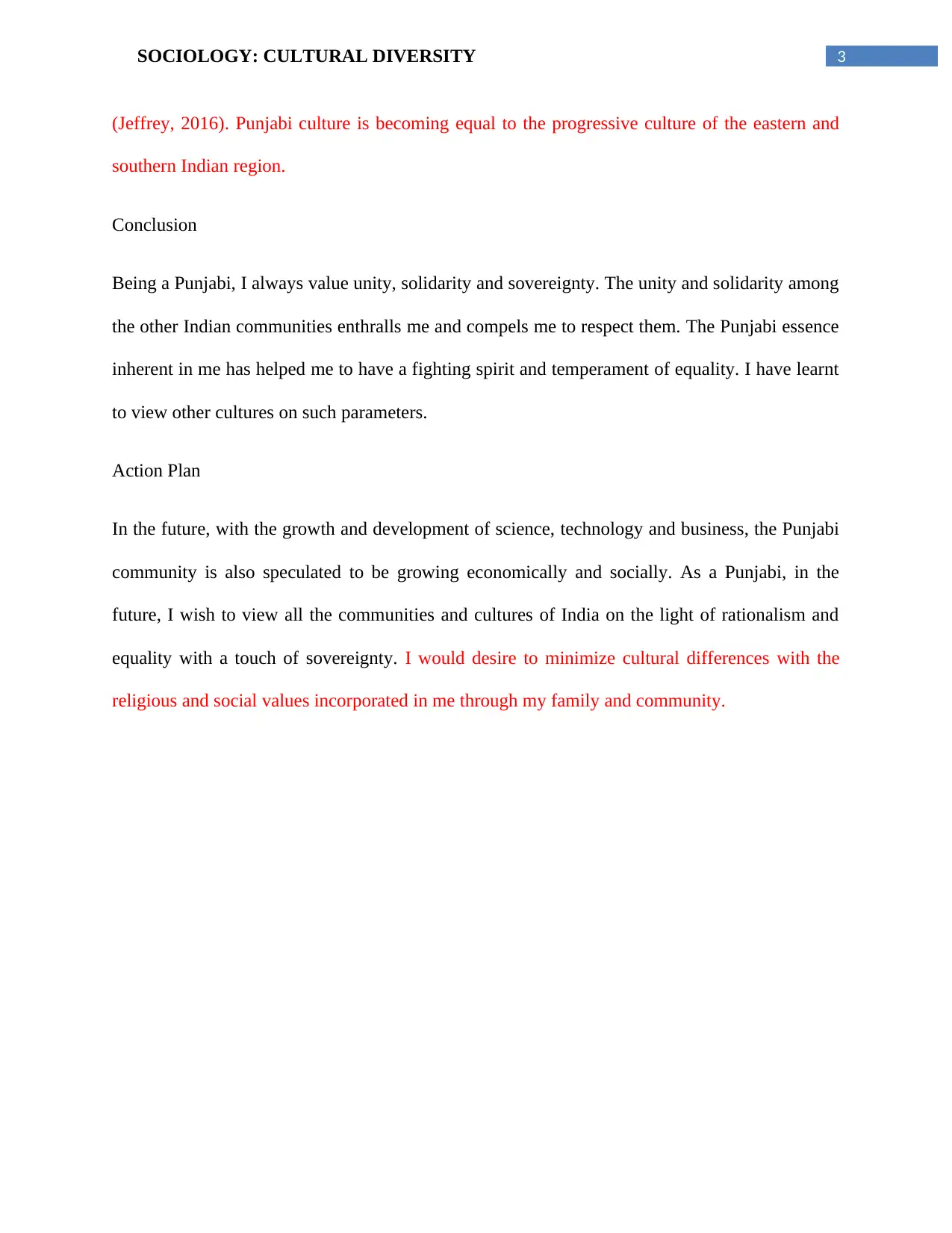
3SOCIOLOGY: CULTURAL DIVERSITY
(Jeffrey, 2016). Punjabi culture is becoming equal to the progressive culture of the eastern and
southern Indian region.
Conclusion
Being a Punjabi, I always value unity, solidarity and sovereignty. The unity and solidarity among
the other Indian communities enthralls me and compels me to respect them. The Punjabi essence
inherent in me has helped me to have a fighting spirit and temperament of equality. I have learnt
to view other cultures on such parameters.
Action Plan
In the future, with the growth and development of science, technology and business, the Punjabi
community is also speculated to be growing economically and socially. As a Punjabi, in the
future, I wish to view all the communities and cultures of India on the light of rationalism and
equality with a touch of sovereignty. I would desire to minimize cultural differences with the
religious and social values incorporated in me through my family and community.
(Jeffrey, 2016). Punjabi culture is becoming equal to the progressive culture of the eastern and
southern Indian region.
Conclusion
Being a Punjabi, I always value unity, solidarity and sovereignty. The unity and solidarity among
the other Indian communities enthralls me and compels me to respect them. The Punjabi essence
inherent in me has helped me to have a fighting spirit and temperament of equality. I have learnt
to view other cultures on such parameters.
Action Plan
In the future, with the growth and development of science, technology and business, the Punjabi
community is also speculated to be growing economically and socially. As a Punjabi, in the
future, I wish to view all the communities and cultures of India on the light of rationalism and
equality with a touch of sovereignty. I would desire to minimize cultural differences with the
religious and social values incorporated in me through my family and community.
Paraphrase This Document
Need a fresh take? Get an instant paraphrase of this document with our AI Paraphraser
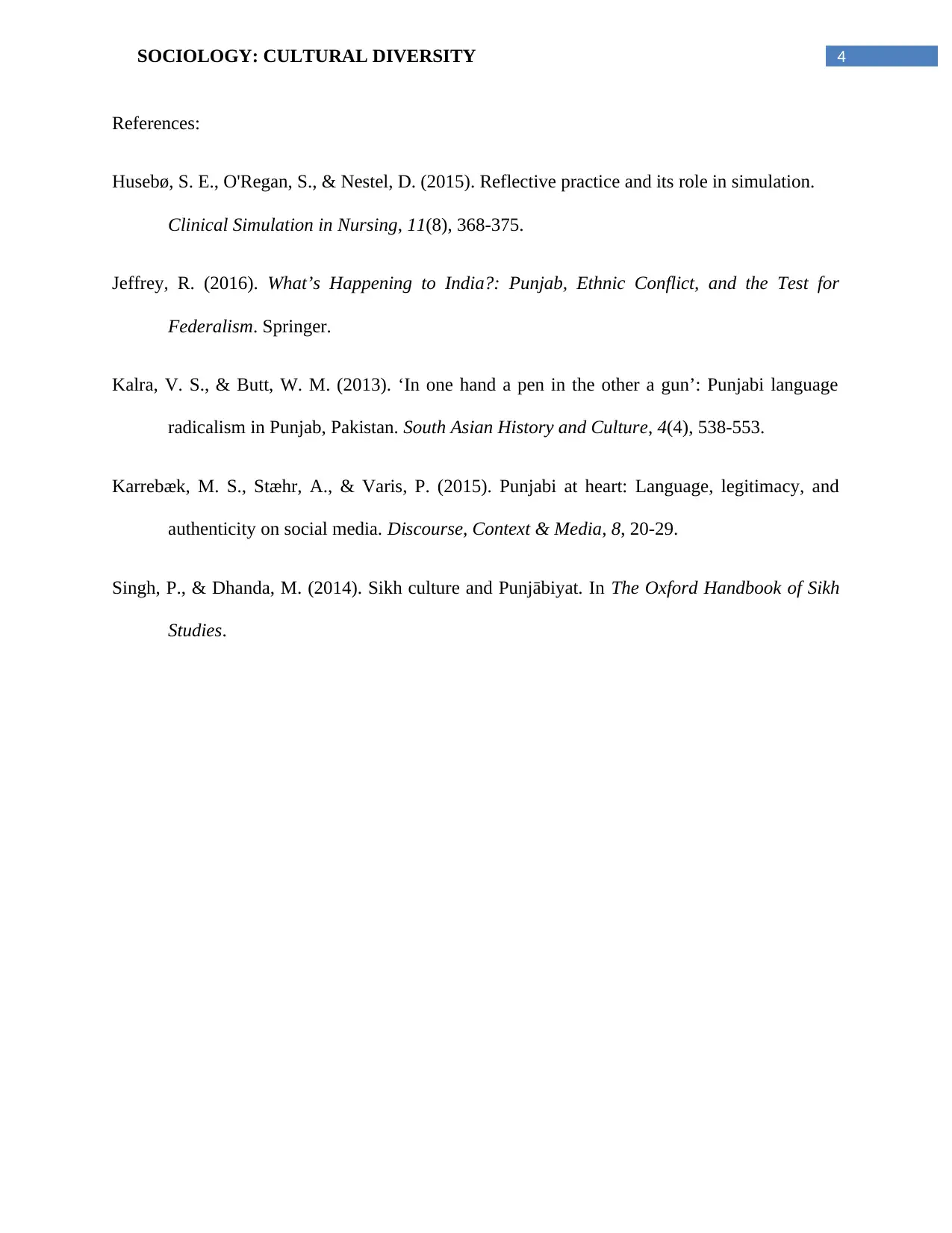
4SOCIOLOGY: CULTURAL DIVERSITY
References:
Husebø, S. E., O'Regan, S., & Nestel, D. (2015). Reflective practice and its role in simulation.
Clinical Simulation in Nursing, 11(8), 368-375.
Jeffrey, R. (2016). What’s Happening to India?: Punjab, Ethnic Conflict, and the Test for
Federalism. Springer.
Kalra, V. S., & Butt, W. M. (2013). ‘In one hand a pen in the other a gun’: Punjabi language
radicalism in Punjab, Pakistan. South Asian History and Culture, 4(4), 538-553.
Karrebæk, M. S., Stæhr, A., & Varis, P. (2015). Punjabi at heart: Language, legitimacy, and
authenticity on social media. Discourse, Context & Media, 8, 20-29.
Singh, P., & Dhanda, M. (2014). Sikh culture and Punjābiyat. In The Oxford Handbook of Sikh
Studies.
References:
Husebø, S. E., O'Regan, S., & Nestel, D. (2015). Reflective practice and its role in simulation.
Clinical Simulation in Nursing, 11(8), 368-375.
Jeffrey, R. (2016). What’s Happening to India?: Punjab, Ethnic Conflict, and the Test for
Federalism. Springer.
Kalra, V. S., & Butt, W. M. (2013). ‘In one hand a pen in the other a gun’: Punjabi language
radicalism in Punjab, Pakistan. South Asian History and Culture, 4(4), 538-553.
Karrebæk, M. S., Stæhr, A., & Varis, P. (2015). Punjabi at heart: Language, legitimacy, and
authenticity on social media. Discourse, Context & Media, 8, 20-29.
Singh, P., & Dhanda, M. (2014). Sikh culture and Punjābiyat. In The Oxford Handbook of Sikh
Studies.
1 out of 5
Related Documents
Your All-in-One AI-Powered Toolkit for Academic Success.
+13062052269
info@desklib.com
Available 24*7 on WhatsApp / Email
![[object Object]](/_next/static/media/star-bottom.7253800d.svg)
Unlock your academic potential
Copyright © 2020–2025 A2Z Services. All Rights Reserved. Developed and managed by ZUCOL.




